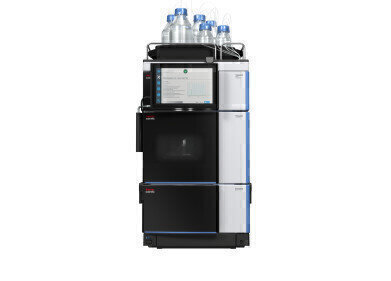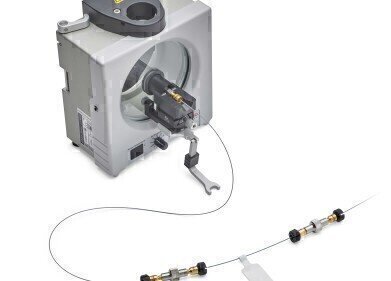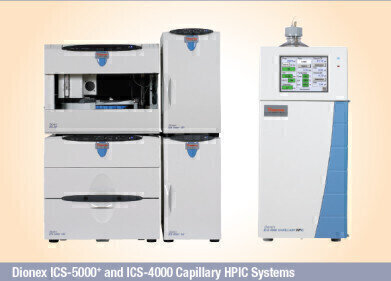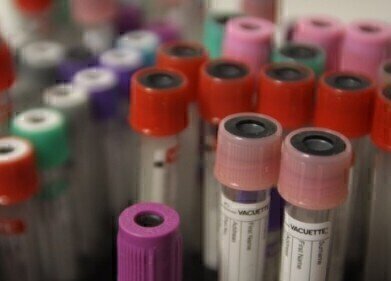-
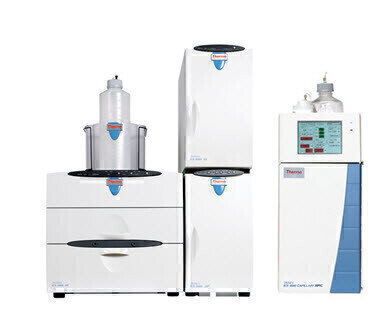 Capillary Ion Chromatography (IC) System.
Capillary Ion Chromatography (IC) System.
Capillary
Why use capillary ion chromatography?
Oct 02 2013
Increasing productivity has become a critical benchmarking metric as laboratories look to operate at near top efficiency within available resources. Capillary ion chromatography (IC) takes performance and ease-of-use to a whole new level, simplifying ion chromatography analyses while increasing throughput. By scaling down column size, injection volumes, and flow rates by a factor of 10 to 100, Capillary IC provides excellent eluent and waste economy, small sample requirements, and high mass sensitivity.
Benefits of Capillary Ion Chromatography include:
Reduced Operating Time
In Capillary IC only 15 mL of water a day is consumed, translating into 5.2 L a year due to the low flow rates of 10 µL/min. As a result, the system can operate with continuous eluent flow, eliminating the need to wait for equilibration.
Costs of Ownership
Waste production is dramatically minimised which reduces disposal costs. When operated as a Reagent-free Ion Chromatography™ (RFIC™) system, the Eluent Generation Cartridge lasts for 18 months under continuous operate mode. This allows maintenance costs to be nominal as the Eluent Generation Cartridge uses water as an eluent, and results in less frequent replacement of pump seals. On a unrelated but important side note, the ability to electrolytically generate the eluent results in accurate and precise eluent delivery, preventing variations typically found in manual eluent preparation.
Faster Time to Results
Capillary IC allows for lower flow rates by optimising column dimensions (i.d. 0.4 mm). The typical flow rate is only 1/100th the eluent flow rate of standard bore format. Standard bore column formats typically run at flow rates of 1 mL/min. Due to the smaller cross-sectional area, the flow rate on a capillary format can be scaled down to 10 µL/min. In capillary IC, the flow rates can be increased up to 3 times, or 30 µL/min.
Improved Sensitivity
The combination of a first-dimension standard bore column (i.d. 4 mm) with a second-dimension capillary column (i.d. 0.4 mm) permits lower detection limits in the low ng/L range.
The Thermo Scientific™ Dionex™ ICS-5000+ and Dionex ICS-4000 HPIC™ Systems are the world’s first capillary ion chromatography (IC) systems on the market. The Dionex ICS-5000+ operates at standard bore, microbore and capillary flow rates at pressures up to 5000 psi enabling it to also perform high-resolution and fast IC analysis with the latest 4 μm particle-size columns. On the other hand, the Dionex ICS-4000 capillary HPIC system is solely dedicated to Capillary IC. This system boasts all of the benefits of Capillary IC discussed, including high-pressure capabilities for high chromatographic resolution. Furthermore, all the Dionex ICS-5000+ and ICS-4000 systems are designed to be compatible with small particle IC columns. These columns aid in facilitating separations up to four times faster than conventional columns.
Learn more about the latest advancements and innovations IC by visiting our Advancement in Ion Chromatography Resource Center where you can access free application notes, on-demand webinars, customer case studies, expert interviews and much more.
Digital Edition
Lab Asia Dec 2025
December 2025
Chromatography Articles- Cutting-edge sample preparation tools help laboratories to stay ahead of the curveMass Spectrometry & Spectroscopy Articles- Unlocking the complexity of metabolomics: Pushi...
View all digital editions
Events
Jan 21 2026 Tokyo, Japan
Jan 28 2026 Tokyo, Japan
Jan 29 2026 New Delhi, India
Feb 07 2026 Boston, MA, USA
Asia Pharma Expo/Asia Lab Expo
Feb 12 2026 Dhaka, Bangladesh
